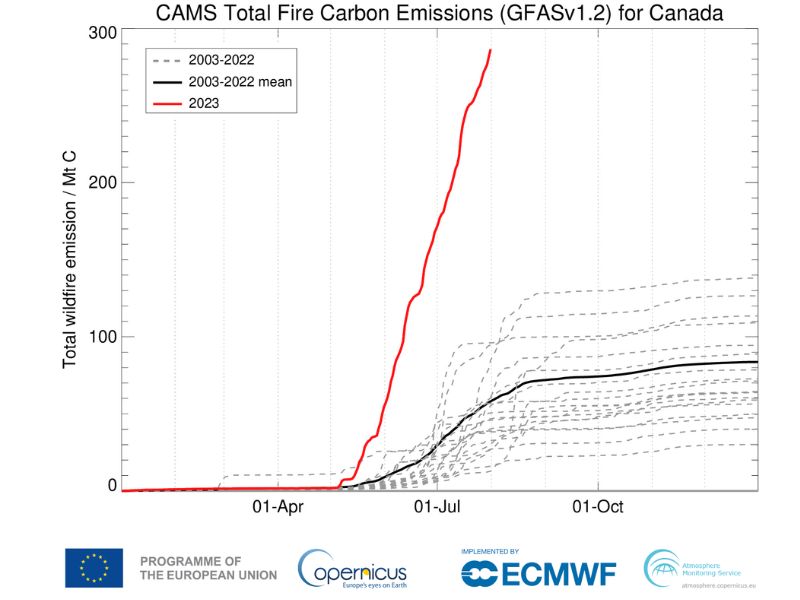
Canada’s wildfire season, which starts in May and lasts until October, had much more fire activity in 2023 than average, especially early on. During May of this year, multiple active fires were quickly spreading at the same time, mostly in Canada’s boreal forests. Because the fires were scattered across separate areas, firefighting resources were spread thin and had difficulty controlling the flames. High temperatures during the spring, dry conditions in forests, and fires from the previous wildfire season that were still burning contributed to the intense start of this year’s wildfires.
The Wildfires In Canada
The wildfires of 2023 are burning across both western and eastern provinces and are already considerably higher than the annual average. On average, something like 2.5 million hectares (6,177,634) burn annually in Canada. At the time of this writing, it is estimated that 18.4 million hectares (well above 45,000,000 acres) have burned, and an estimated 748 fires are still active, according to the Canadian Interagency Forest Fire Center. The total area burned is more than double the previous record high of 17.5 million acres (7.1 million hectares), set back in 1995. No other Canadian wildfire season has burned more forest area or produced more carbon emissions than 2023.
The carbon dioxide emissions from the fires have also set new records. The European Union’s Copernicus Atmosphere Monitoring Service (CAMS), which provides up-to-date information on the location, intensity, and estimated emissions of global fires, reports that the carbon dioxide emissions have already doubled the previous annual record. Their data reflects nearly 290 megatons of carbon from the fires. The previous record was 138 megatons, in 2014.

How Did the Canada Wildfires Start 2023
Their results indicate that temperature, relative humidity, wind speed, and 24-hour precipitation which gave rise to Canada’s 2023 wildfire season were made at least seven times more likely to occur as a result of climate change. I.e., climate change amplified the hot, dry and windy conditions that allow wildfires to start and spread efficiently. The WWA group also claim that human-caused climate change has made the “peak fire weather” experienced this year no less than twice as likely, with an increased intensity of about 20%.
A study produced by the World Weather Attribution (WWA), an international group of scientists who study the role of extreme weather events such as heat waves, droughts, heavy rainfall, and floods in climate change, assessed the eastern fires in Canada in 2023. The WWA proposes that the fires in the east were unusually active during this wildfire season and are most directly linked with the impacts on air quality. To identify whether human-caused climate change impacted the wildfires in Eastern Canada, the WWA group created climate models that simulate an imaginary scenario: a scenario in which the global climate has not been warmed (roughly 2° Celsius) by human activity. They used the same sets of climate models to simulate the actual world, which has been warmed by climate change. The group then observed the likelihood of “fire weather” such as that during Canada’s intense 2023 wildfire season.
Canada Wildfire Smoke
The most far-reaching aspect of the wildfires has been the migrating plumes of smoke. As the fires burned, dark clouds and particulate matter rose into the air and drifted via wind currents into large portions of southern Ontario, the United States, and Europe. The fumes dimmed sunlight and left the skies gloomy. Some people even reported a burning smell outside their homes. Air quality alerts warned that inhaling smoke could pose dangerous health effects. The hazardous particulate matter in wildfire smoke can impair lung and heart function, especially for sensitive groups such as those with respiratory issues.
How Do Wildfires Start

Wildfires are a common type of natural disaster that can be started by lightning strikes, volcanic lava, meteor impacts, and coal-seam fire. People too, cause wildfires, and by leaving campfires unattended, or discarding lit cigarettes, and, most commonly, by improperly maintaining electrical power systems.
These large, destructive fires are characteristically unplanned and uncontrolled. Grasslands, forested areas, and shrublands are among the most susceptible environments due to the high degree of vegetation in and above the soil. Wildfires need an initial heat source, fuel (some combustible material to burn), and oxygen to start.
Extended periods of drought combined with warm temperatures also create suitable conditions for wildfires. During periods of extremely high temperatures and drought, rates of evapotranspiration (the combined evaporation processes of surface water evaporation, soil moisture evaporation, and plant transpiration) are going to be relatively high. In other words, high temperatures and drought drive water loss from the ground, soils, and plants. Dried-out plant matter acts as kindling during wildfires, allowing flames to spread more quickly.
Researchers from the International Panel on Climate Change (IPCC) have warned that climate change is adding to the severity and frequency of wildfires. In their “Land-climate Interactions” report, the IPCC states that fire seasons have lengthened globally between 1979 and 2013 and that there has been increased fire activity in certain temperate and tropical areas due enhanced vegetation flammability.
Leave a Reply